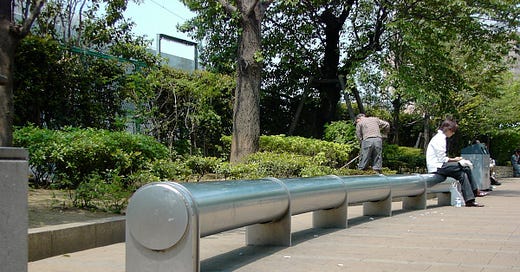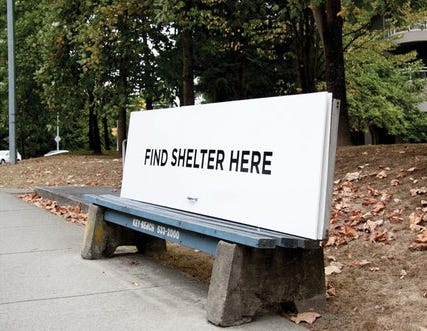Welcome to the Ubik Blog!
If you haven’t already subscribed, subscribe here!
The Gate Kept Public.
Exploring Hostile Architecture in NYC
Living in Fear
In my Flatbush apartment, there is a constant battle between us and them—the roaches. No matter how hard we try, they inevitably find a new crack to slip through. Borax Solution is a transparent gel for baiting and killing cockroaches—a classic NYC defense method. We line the cracks in the walls and the holes in the drain. We clean until every crumb is in the trash and out of sight. We defend our space selfishly.
Truthfully, the cockroaches predate our arrival at Apt 3F. We live in 3F; the building is their home. Structural issues that seem unsolvable. We try to make them invisible.
What is hostile architecture?
Hostile Architecture is the development of public property designed to expel undesired behavior by people and animals. Most commonly designed to deter homeless people, such as curved benches and spike covered pavements, are intended to prevent homeless people from loitering or sleeping safely.
Hostile architecture is the last line of defense for public spaces.
Still, with a homeless population of 600 thousand in the United States, public spaces have become increasingly uncomfortable for everyone, not just those without homes. With brutalist benches and spike-covered sidewalks, like transparent gel used to bait roaches, Hostile Architecture is an invisible fix to a massive structural problem in the United States: Homelessness.
The Anti-Public
Here is a list of a few examples of hostile architecture in NYC and many other cities globally.
Anti-sleep bench
Flat ones - more like a leaning wall.
Armrests to ensure no one lays down.
Curved benches - make it painful to sleep.
New lifted grates in NYC.
Ensures nobody sleeps over the warm vent from the subway.
It offers public seating, but it is not enough.
Although modern looking, it’s pretty uncomfortable.
Spikes
Spikes prevent loitering and sleeping.
Installed on pavement outside storefronts or under overpasses.
Many small businesses do this directly outside the storefront so nobody can sit near them. (Not just homeless people)
Security Cameras
Implemented based on the "likelihood" of crime.
People of color are surveilled disproportionately in the US (Lowe, Romero, & Carrola, 2023).
Fencing off Covered Areas
Using walls, spikes, fences, and rocks so no one can build a home for privacy or protection from the snow or rain.
A Lack of Public Seating
Intentionally leaving out seating in public spaces to enforce that homeless people cannot stay.
No one can sit on the floor in these places, or police will tell you to leave.
Homelessness in NYC
As New Yorkers, our bar for high-quality public spaces is very low. Being isolated and far from other examples of comparable cities makes self-critique nearly impossible. Using London as an example, even though the English have pioneered some of the most broadly used hostile architectural designs, compared to NYC, the difference in the homeless population is astounding. NYC makes up around 20 percent of the US homeless population; that's more than 100 thousand homeless people in the most densely populated city in the US (The Bowery Mission, 2023).
Hostile architecture in NYC is felt by many and very blatantly, while London's homeless population in 2023 inclined to 10,053 "rough sleepers," or homeless people (Trust for London, n.d.). That’s 10x less than NYC!
You Shall Not Sit!
While hostile architecture attempts to deter "unwanted" individuals, Moynihan Train Hall in NYC, the most recent addition to the MTA system, is a hostile environment for everyone. As we can see from the picture above, there are no seats or displays for train information. Open for two years now; the complaints have continued.
What started as a "defense" method against homelessness has now become a collective pain point felt by thousands daily, leading to "a coalition of federal, state, and city lawmakers calling on the MTA and Amtrak to install benches in the cavernous main hall, which currently doesn't have any seating" (Nessen, 2022).
Due to widespread gentrification and profit incentives, the city still overlooks humane city planning methods. After spending 1.6 billion on Moynihan Train Hall, New Yorkers continue to stand, wait, and stare at ads for luxury items instead of being comfortable and informed about their train times.
Hostile Architecture = Hostile Cities
Structural issues and poor city planning, like a lack of seating in public spaces, fuel the NYC homeless endemic. To strategically prevent 100 thousand people from public spaces while offering them little to no social help results in a hostile city, not just a hostile bench or public park.
Like Moynihan Train Hall, the Fulton Transit Center (1.4 billion dollars), and the NYC Oculus (4 billion dollars) are beautiful architectural achievements that get walked through quickly and remain unappreciated due to discomfort. These three billion-dollar or more contracts keep people from lingering. Making these spaces highly inaccessible and dangerous for older adults, families with young children, and, of course, anyone with physical disabilities or injuries trying to travel cautiously.
The city actively chooses to dismiss these needs in hopes that public spaces become more "civil"; however, the methods city officials take to reach this "civility" are ironically "uncivil." Choosing to hide homelessness does not fix the issue. It proliferates the problem and prevents change from happening.
What should we do?
The Bench Project by Raincity Housing or Public Sleep Pods, built in Ulm, Germany, is an excellent example of how including safe sleep and rain protection shifts our perception of how homeless people should be treated in public spaces. Building walls breaks communities, and fighting for initiatives that tear down social boundaries means making public spaces welcoming for everyone.
Designing “inclusive” architecture means building public spaces with homeless populations in mind. But public spaces and hostile architecture aren’t the crux of the issue. We should fight for homes, not spikes. Public/social housing is the real solution. In cities like NYC, we shouldn’t treat those without homes like pests. The development of hostile architecture is a clear message to those seeking help; none is available here.
Work Cited
Lowe, M. R., Romero, L. A., & Carrola, M. (2023). “Racism Masked as Safety Concerns”: The Experiences of Residents of Color With Racialized Coveillance in a Predominantly White Neighborhood. Sociology of Race and Ethnicity. https://doi.org/10.1080/09505431.2018.1523887
Neighborhood Design Center. (2023, October 2). Understanding hostile architecture: The cause and effect of restricting public space. Retrieved from https://ndc-md.org/news-and-stories/understanding-hostile-architecture-the-cause-and-effect-of-restricting
Nessen, S. (2022, February 22). Lawmakers call for more seating in the $1.6 billion Moynihan Train Hall. Gothamist. Retrieved from gothamist.com/news/lawmakers-call-more-seating-16-billion-moynihan-train-hall
The Bowery Mission. (2023). Homelessness & poverty in New York City. Retrieved from www.bowery.org/homelessness/#:~:text=How%20many%20people%20are%20homeless,one%20of%20the%20other%20boroughs.
Trust for London. (n.d.). People sleeping rough. Trust for London. Retrieved February 8, 2024, from https://trustforlondon.org.uk/data/rough-sleeping-london/#:~:text=The%20number%20of%20people%20sleeping,in%202022%2F23%20to%2010%2C053.
Here’s some important stuff you should check out :)
The future of trash is here! NYC shows off new garbage trucks.
An adaptive robot that can open any door!











